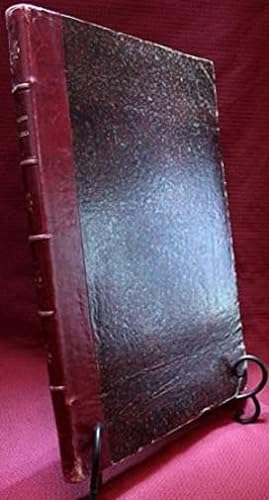ROSNY LOUIS LEON PRUNOL DE 1837 1914 (2 resultados)
Tipo de artículo
- Todo tipo de artículos
- Libros (2)
- Revistas y publicaciones
- Cómics
- Partituras
- Arte, grabados y pósters
- Fotografías
- Mapas
-
Manuscritos y
coleccionismo de papel
Condición
Encuadernación
- Todo
- Tapa dura
- Tapa blanda
Más atributos
- Primera edición (1)
- Firmado
- Sobrecubierta
- Con imágenes del vendedor
- Sin impresión bajo demanda (1)
Gastos de envío gratis
Ubicación del vendedor
Valoración de los vendedores
-
Revue orientale et américaine [Reprint] [Leatherbound]
Publicado por Pranava Books, 2020
Librería: S N Books World, Delhi, India
Libro Impresión bajo demanda
Leatherbound. Condición: NEW. Leatherbound edition. Condition: New. Language: fre Leather Binding on Spine and Corners with Golden leaf printing on spine. Reprinted from edition. NO changes have been made to the original text. This is NOT a retyped or an ocr'd reprint. Illustrations, Index, if any, are included in black and white. Each page is checked manually before printing. As this print on demand book is reprinted from a very old book, there could be some missing or flawed pages, but we always try to make the book as complete as possible. Fold-outs, if any, are not part of the book. If the original book was published in multiple volumes then this reprint is of only one volume, not the whole set. IF YOU WISH TO ORDER PARTICULAR VOLUME OR ALL THE VOLUMES YOU CAN CONTACT US. Sewing binding for longer life, where the book block is actually sewn (smythe sewn/section sewn) with thread before binding which results in a more durable type of binding. THERE MIGHT BE DELAY THAN THE ESTIMATED DELIVERY DATE DUE TO COVID-19. Pages: 503 Pages: 503.
-
Ensayo sobre la interpretación de la escritura hierática de la América Central
Publicado por Imprenta y Fundicion de Manuel Tello, Madrid, 1881
Librería: The Book Collector, Inc. ABAA, ILAB, Fort Worth, TX, Estados Unidos de America
Libro Original o primera edición
Hardcover. Condición: Very Good. 1st Edition. [8]+xxi+113+[5] pages with figures, drawings (some in color) and xx leaves of plates of which number XX folds out. Elephant folio (18" x 12") bound in quarter red leather with six raised band compartments lettered and decorated in gilt over marbled boards. Translated by Juan de Dios de la Rada and Delgado. First Spanish edition limited to 200 copies of which this is number 141. This Spanish-language translation of Rosny's essay on hieroglyphic writing is from the Codex Troano, which was named for a previous owner, Don Juan Tro and Ortolano, a professor of Spanish palaeography. In his prologue to this book, Juan Rada and Delgado endorses Rosny's assertion that the Maya codex purchased by a Madrid museum in 1875 and named Codex Cortesianus is truly part of the same book as the Codex Troano, which was discovered in Spain in the 1860s By Brasseur de Bourbourg. The two fragments were reunited in 1888, and the whole is now known as the Madrid Codex. The reconnected manuscript consists of fifty-six leaves, with writing on both sides. Its date has been disputed, with most scholars believing that it was executed late in the Post-Classic period but before the Spanish invasion. With the formation of the Societe Americaine de France established in 1857, primarily with the enthusiasm of Braseur de Borubourg and a small number of scholars and among them was Leon Louis Lucien Prunol de Rosny (1837-1914), a student and later professor in the School of Oriental Languages who did extensive research on the language and writing systems of the Far East. Rosny's special concern was Japanese, but also studied, Chinese, Korean and the languages of Southeast Asia. His distinguished career included the important position of director of the Ecole des Hautes Estudes (Sorbonne). Equipped with a comparative background in languages and writing systems held by few other students of Maya writing, Rosny approached the problem of decipherment with considerable rigor. His background allowed him to recognize the mixed nature of the Maya system, in which he identified "figurative," "idiographic" and "phonetic" signs. He also understood the problems in using Landa's alphabet, but nonetheless asserted its basically syllabic nature. Only a handful of his original decipherments have stood the test of time, most conspicuously his clever elucidation of the Cortesianus (1883) and Persianus (1887) Codices. The story of the Paris Codex or Peresianus is evocative of Latin America's image abroad. One day in Paris, Rosny ran across this manuscript while looking into a "basket of papers in a neglected part of the library. The twenty-two-page document, bearing the name "Perez" (a library staff member who worked on this codex in 1859), had disappeared before Jose Perez found it. Rosny published a colorful and historic study entitled Codex Peresianus, Manuscrit hieratique des anciens iondiens de l'Amerique centrale conserve a la Biblioteque Nationale de Paris. Scholars prefer to use the name Paris instead of Peresianusto avoid any confusion with a codex known as Codice Perez (The Book of Chilam Balam of Mani). Condition: Corners gently bumped, plates professionally re-hinged else a very good copy of an rare item.


![Imagen del vendedor de Revue orientale et américaine [Reprint] [Leatherbound] a la venta por S N Books World](https://pictures.abebooks.com/inventory/md/md30700843998.jpg)
